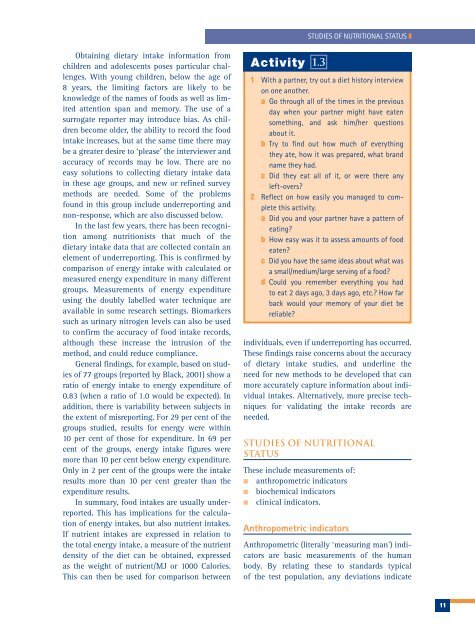Human Nutrition
Human Nutrition
Human Nutrition
You also want an ePaper? Increase the reach of your titles
YUMPU automatically turns print PDFs into web optimized ePapers that Google loves.
STUDIES OF NUTRITIONAL STATUS ❚<br />
Obtaining dietary intake information from<br />
children and adolescents poses particular challenges.<br />
With young children, below the age of<br />
8 years, the limiting factors are likely to be<br />
knowledge of the names of foods as well as limited<br />
attention span and memory. The use of a<br />
surrogate reporter may introduce bias. As children<br />
become older, the ability to record the food<br />
intake increases, but at the same time there may<br />
be a greater desire to ‘please’ the interviewer and<br />
accuracy of records may be low. There are no<br />
easy solutions to collecting dietary intake data<br />
in these age groups, and new or refined survey<br />
methods are needed. Some of the problems<br />
found in this group include underreporting and<br />
non-response, which are also discussed below.<br />
In the last few years, there has been recognition<br />
among nutritionists that much of the<br />
dietary intake data that are collected contain an<br />
element of underreporting. This is confirmed by<br />
comparison of energy intake with calculated or<br />
measured energy expenditure in many different<br />
groups. Measurements of energy expenditure<br />
using the doubly labelled water technique are<br />
available in some research settings. Biomarkers<br />
such as urinary nitrogen levels can also be used<br />
to confirm the accuracy of food intake records,<br />
although these increase the intrusion of the<br />
method, and could reduce compliance.<br />
General findings, for example, based on studies<br />
of 77 groups (reported by Black, 2001) show a<br />
ratio of energy intake to energy expenditure of<br />
0.83 (when a ratio of 1.0 would be expected). In<br />
addition, there is variability between subjects in<br />
the extent of misreporting. For 29 per cent of the<br />
groups studied, results for energy were within<br />
10 per cent of those for expenditure. In 69 per<br />
cent of the groups, energy intake figures were<br />
more than 10 per cent below energy expenditure.<br />
Only in 2 per cent of the groups were the intake<br />
results more than 10 per cent greater than the<br />
expenditure results.<br />
In summary, food intakes are usually underreported.<br />
This has implications for the calculation<br />
of energy intakes, but also nutrient intakes.<br />
If nutrient intakes are expressed in relation to<br />
the total energy intake, a measure of the nutrient<br />
density of the diet can be obtained, expressed<br />
as the weight of nutrient/MJ or 1000 Calories.<br />
This can then be used for comparison between<br />
Activity 1.3<br />
1 With a partner, try out a diet history interview<br />
on one another.<br />
a Go through all of the times in the previous<br />
day when your partner might have eaten<br />
something, and ask him/her questions<br />
about it.<br />
b Try to find out how much of everything<br />
they ate, how it was prepared, what brand<br />
name they had.<br />
c Did they eat all of it, or were there any<br />
left-overs?<br />
2 Reflect on how easily you managed to complete<br />
this activity.<br />
a Did you and your partner have a pattern of<br />
eating?<br />
b How easy was it to assess amounts of food<br />
eaten?<br />
c Did you have the same ideas about what was<br />
a small/medium/large serving of a food?<br />
d Could you remember everything you had<br />
to eat 2 days ago, 3 days ago, etc.? How far<br />
back would your memory of your diet be<br />
reliable?<br />
individuals, even if underreporting has occurred.<br />
These findings raise concerns about the accuracy<br />
of dietary intake studies, and underline the<br />
need for new methods to be developed that can<br />
more accurately capture information about individual<br />
intakes. Alternatively, more precise techniques<br />
for validating the intake records are<br />
needed.<br />
Studies of nutritional<br />
status<br />
These include measurements of:<br />
■ anthropometric indicators<br />
■ biochemical indicators<br />
■ clinical indicators.<br />
Anthropometric indicators<br />
Anthropometric (literally ‘measuring man’) indicators<br />
are basic measurements of the human<br />
body. By relating these to standards typical<br />
of the test population, any deviations indicate<br />
11

















